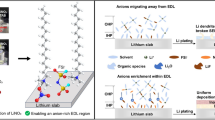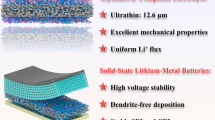Abstract
A new composite polymer electrolyte membrane composed of hyperbranched star polymers (HBPS-(PMMA-b-PPEGMA)30 (the hyperbranched star polymer with hyperbranched polystyrene as core and polymethyl methacrylate block poly(ethylene glycol) methyl ether methacrylate) as arms)), ionic liquid (1-butyl-3-methylimidazolium tetrafluoroborate (BMImBF4) or 1-butyl-3-methylimidazolium hexafluorophosphate (BMImPF6)), and lithium bis(trifluoromethanesulfonyl) imide (LiTFSI) has been fabricated by solution casting method. This type of solid polymer electrolyte membrane shows an excellent flexibility, transparency, and free-standing properties. Room temperature ionic conductivity of composite electrolytes with 40 wt% BMImBF4 or 40 wt% BMImPF6 can reach 2.5 × 10−4 and 4.1 × 10−5 S cm−1, respectively. The HBPS-(PMMA-b-PPEGMA)30/BMImPF6/LiTFSI (the composite polymer electrolyte with 1-butyl-3-methylimidazolium hexafluorophosphate) composite polymer electrolyte displays better performances including a good thermal stability with decomposition temperature of 350 °C, a wide electrochemical window with oxidation potential of 4.3 V, and the excellent interfacial compatibility with lithium electrode. Moreover, the Li/LiFePO4 batteries based on HBPS-(PMMA-b-PPEGMA)30/BMImPF6/LiTFSI electrolyte retain about 96% of their highest discharge capacity (120.5 mAh g−1) after 100 cycles under a current density of 0.1 C at 60 °C, exhibiting the excellent reversible cyclability.

The free-standing composite electrolyte films composed of ionic liquids, hyperbranched star polymers and lithium salts show the high ionic conductivities.








Similar content being viewed by others
References
Lu QW, Yang J, Lu W, Wang JL, Nuli Y (2015) Advanced semi-interpenetrating polymer network gel electrolyte for rechargeable lithium batteries. Electrochim Acta 152:489–495
Hu Y, Sun X (2014) Flexible rechargeable lithium ion batteries: advances and challenges in materials and process technologies. J Mater Chem A 2(28):10712–10738
Zhou G, Li F, Cheng H-M (2014) Progress in flexible lithium batteries and future prospects. Energy Environ Sci 7(4):1307–1338
Sengodu P, Deshmukh AD (2015) Conducting polymers and their inorganic composites for advanced Li-ion batteries: a review. RSC Adv 5(52):42109–42130
Jung Y, Kim S, Kim M, Lee J, Han M, Kim D, Shin W, Ue M, Kim D (2015) Ceramic separators based on Li+-conducting inorganic electrolyte for high-performance lithium-ion batteries with enhanced safety. J Power Sources 293:675–683
Kimura K, Hassoun J, Panero S, Scrosati B, Tominaga Y (2015) Electrochemical properties of a poly(ethylene carbonate)-LiTFSI electrolyte containing a pyrrolidinium-based ionic liquid. Ionics 21(3):895–900
Tarascon JM, Armand M (2001) Issues and challenges facing rechargeable lithium batteries. Nature 414(6861):359–367
Quartarone E, Mustarelli P (2011) Electrolytes for solid-state lithium rechargeable batteries: recent advances and perspectives. Chem Soc Rev 40(5):2525–2540
Wang Q, Song W-L, Fan L-Z, Song Y (2015) Flexible, high-voltage and free-standing composite polymer electrolyte membrane based on triethylene glycol diacetate-2-propenoic acid butyl ester copolymer for lithium-ion batteries. J Membrane Sci 492:490–496
Wang Y, Zhong W-H (2015) Development of electrolytes towards achieving safe and high-performance energy-storage devices: a review. Chem Aust 2(1):22–36
Higa M, Fujino Y, Koumoto T, Kitani R, Egashira S (2005) All solid-state polymer electrolytes prepared from a hyper-branched graft polymer using atom transfer radical polymerization. Electrochim Acta 50(19):3832–3837
Zhang Z, Sui G, Bi H, Yang X (2015) Radiation-crosslinked nanofiber membranes with well-designed core-shell structure for high performance of gel polymer electrolytes. J Membrane Sci 492:77–87
Taib NU, Idris NH (2014) Plastic crystal-solid biopolymer electrolytes for rechargeable lithium batteries. J Membrane Sci 468:149–154
Peng X, Zhou L, Jing B, Cao Q, Wang X, Tang X, Zeng J (2015) A high-performance electrospun thermoplastic polyurethane/poly(vinylidene fluoride-co-hexafluoropropylene) gel polymer electrolyte for Li-ion batteries. J Solid State Electr 20(1):255–262
Wang Q, Song W-L, Fan L-Z, Song Y (2015) Facile fabrication of polyacrylonitrile/alumina composite membranes based on triethylene glycol diacetate-2-propenoic acid butyl ester gel polymer electrolytes for high-voltage lithium-ion batteries. J Membrane Sci 486:21–28
Nunes-Pereira J, Costa CM, Lanceros-Mendez S (2015) Polymer composites and blends for battery separators: state of the art, challenges and future trends. J Power Sources 281:378–398
Garcia B, Lavallee S, Perron G, Michot C, Armand M (2004) Room temperature molten salts as lithium battery electrolyte. Electrochim Acta 49(26):4583–4588
Guerfi A, Duchesne S, Kobayashi Y, Vijh A, Zaghib K (2008) LiFePO4 and graphite electrodes with ionic liquids based on bis(fluorosulfonyl)imide (FSI)(-) for Li-ion batteries. J Power Sources 175(2):866–873
Xu K (2004) Nonaqueous liquid electrolytes for lithium-based rechargeable batteries. Chem Rev 104(10):4303–4417
Appetecchi GB, Montanino M, Balducci A, Lux SF, Winterb M, Passerini S (2009) Lithium insertion in graphite from ternary ionic liquid-lithium salt electrolytes I. Electrochemical characterization of the electrolytes. J Power Sources 192(2):599–605
Lewandowski A, Swiderska-Mocek A (2007) Properties of the graphite-lithium anode in N-methyl-N-propylpiperidinium bis(trifluoromethanesulfonyl) imide as an electrolyte. J Power Sources 171(2):938–943
Balducci A, Jeong SS, Kim GT, Passerini S, Winter M, Schmuck M, Appetecchi GB, Marcilla R, Mecerreyes D, Barsukov V, Khomenko V, Cantero I, De Meatza I, Holzapfel M, Tran N (2011) Development of safe, green and high performance ionic liquids-based batteries (ILLIBATT project). J Power Sources 196(22):9719–9730
Pont A-L, Marcilla R, De Meatza I, Grande H, Mecerreyes D (2009) Pyrrolidinium-based polymeric ionic liquids as mechanically and electrochemically stable polymer electrolytes. J Power Sources 188(2):558–563
Chopade SA, So SY, Hillmyer MA, Lodge TP (2016) Anhydrous proton conducting polymer electrolyte membranes via polymerization-induced microphase separation. ACS Appl Mater Interfaces 8(9):6200–6210
Shin JH, Henderson WA, Scaccia S, Prosini PP, Passerini S (2006) Solid-state Li/LiFePO4 polymer electrolyte batteries incorporating an ionic liquid cycled at 40 degrees C. J Power Sources 156(2):560–566
Rupp B, Schmuck M, Balducci A, Winter M, Kern W (2008) Polymer electrolyte for lithium batteries based on photochemically crosslinked poly(ethylene oxide) and ionic liquid. Eur Polym J 44(9):2986–2990
Shin JH, Henderson WA, Appetecchi GB, Alessandrini E, Passerini S (2005) Recent developments in the ENEA lithium metal battery project. Electrochim Acta 50(19):3859–3865
Kim GT, Appetecchi GB, Carewska M, Joost M, Balducci A, Winter M, Passerini S (2010) UV cross-linked, lithium-conducting ternary polymer electrolytes containing ionic liquids. J Power Sources 195(18):6130–6137
Shin JH, Henderson WA, Passerini S (2003) Ionic liquids to the rescue? Overcoming the ionic conductivity limitations of polymer electrolytes. Electrochem Commun 5(12):1016–1020
Stepniak I, Andrzejewska E, Dembna A, Galinski M (2014) Characterization and application of N-methyl-N-propylpiperidinium bis(trifluoromethanesulfonyl)imide ionic liquid-based gel polymer electrolyte prepared in situ by photopolymerization method in lithium ion batteries. Electrochim Acta 121:27–33
Deng FL, Wang XE, He D, Hu J, Gong CL, Ye YS, Xie XL, Xue ZG (2015) Microporous polymer electrolyte based on PVDF/PEO star polymer blends for lithium ion batteries. J Membrane Sci 491:82–89
Hu XL, Hou GM, Zhang MQ, Zhang RX, Ruan WH, Huang YF (2016) Studies on solid-state polymer composite electrolyte of nano-silica/hyperbranched poly(amine-ester). J Solid State Electr 20(7):1845–1854
Marzantowicz M, Dygas JR, Krok F, Tomaszewska A, Florjańczyk Z, Zygadło-Monikowska E, Lapienis G (2009) Star-branched poly(ethylene oxide) LiN(CF3SO2)2: a promising polymer electrolyte. J Power Sources 194(1):51–57
Wang A, Xu H, Zhou Q, Liu X, Li Z, Gao R, Wu N, Guo Y, Li H, Zhang L (2016) A new all-solid-state hyperbranched star polymer electrolyte for lithium ion batteries: synthesis and electrochemical properties. Electrochim Acta 212:372–379
Czerwinska M, Sikora A, Szajerski P, Zielonka J, Adamus J, Marcinek A, Piech K, Bednarek P, Bally T (2006) Anthralin: primary products of its redox reactions. J Org Chem 71(14):5312–5319
L-y L, Wang B, Yang H-m, W-x C, Li J (2011) The direct substitutions of 9H-xanthen-9-ol with indoles in a room temperature ionic liquid medium BmimBF4. Tetrahedron Lett 52(43):5636–5639
Namboodiri VV, Varma RS (2002) Solvent-free sonochemical preparation of ionic liquids. Org Lett 4(18):3161–3163
Shimojo K, Goto M (2004) Solvent extraction and stripping of silver ions in room-temperature ionic liquids containing calixarenes. Anal Chem 76(17):5039–5044
Evans J, Vincent CA, Bruce PG (1987) Electrochemical measurement of transference numbers in polymer electrolytes. Polymer 28(13):2324–2328
Watanabe M, Nagano S, Sanui K, Ogata N (1988) Estimation of Li+ transport number in polymer electrolytes by the combination of complex impedance and potentiostatic polarization measurements. Solid State Ionics 28:911–917
Abraham KM, Jiang Z, Carroll B (1997) Highly conductive PEO-like polymer electrolytes. Chem Mater 9(9):1978–1988
Zhang H, Liu C, Zheng L, Feng W, Zhou Z, Nie J (2015) Solid polymer electrolyte comprised of lithium salt/ether functionalized ammonium-based polymeric ionic liquid with bis(fluorosulfonyl)imide. Electrochim Acta 159:93–101
Shalu CSK, Singh RK, Chandra S (2015) Electrical, mechanical, structural, and thermal behaviors of polymeric gel electrolyte membranes of poly(vinylidene fluoride-co-hexafluoropropylene) with the ionic liquid 1-butyl-3-methylimidazolium tetrafluoroborate plus lithium tetrafluoroborate. J Appl Polym Sci 132(7)
He R, Kyu T (2016) Effect of plasticization on ionic conductivity enhancement in relation to glass transition temperature of crosslinked polymer electrolyte membranes. Macromolecules 49(15):5637–5648
Shin JH, Henderson WA, Passerini S (2005) PEO-based polymer electrolytes with ionic liquids and their use in lithium metal-polymer electrolyte batteries. J Electrochem Soc 152(5):A978–A983
Reiter J, Vondrak J, Michalek J, Micka Z (2006) Ternary polymer electrolytes with 1-methylimidazole based ionic liquids and aprotic solvents. Electrochim Acta 52(3):1398–1408
Diaw A, Chagnes A, Carre B, Willmann P, Lemordant D (2005) Mixed ionic liquid as electrolyte for lithium batteries. J Power Sources 146(1–2):682–684
Marzantowicz M, Pozyczka K, Brzozowski M, Dygas JR, Krok F, Florjanczyk Z, Lapienis G (2014) From polymer to polyelectrolyte: studies of star-branched poly(ethylene oxide) with lithium functional groups. Electrochim Acta 115:612–620
Cui Z, Xu Y, Zhu L, Wang J, Xi Z, Zhu B (2008) Preparation of PVDF/PEO-PPO-PEO blend microporous membranes for lithium ion batteries via thermally induced phase separation process. J Membrane Sci 325(2):957–963
Raphael E, Avellaneda CO, Manzolli B, Pawlicka A (2010) Agar-based films for application as polymer electrolytes. Electrochim Acta 55(4):1455–1459
Gorecki W, Jeannin M, Belorizky E, Roux C, Armand M (1995) Physical properties of solid polymer electrolyte PEO(LiTFSI) complexes. J Phys Math 7(34):6823–6832
Rojas AA, Inceoglu S, Mackay NG, Thelen JL, Devaux D, Stone GM, Balsara NP (2015) Effect of lithium-ion concentration on morphology and ion transport in single-ion-conducting block copolymer electrolytes. Macromolecules 48(18):6589–6595
Feng S, Shi D, Liu F, Zheng L, Nie J, Feng W, Huang X, Armand M, Zhou Z (2013) Single lithium-ion conducting polymer electrolytes based on poly[(4-styrenesulfonyl)(trifluoromethanesulfonyl)imide] anions. Electrochim Acta 93:254–263
Fernicola A, Croce F, Scrosati B, Watanabe T, Ohno H (2007) LiTFSI-BEPyTFSI as an improved ionic liquid electrolyte for rechargeable lithium batteries. J Power Sources 174(1):342–348
Peng CX, Yang L, Wang BF, Zhang ZX, Li N (2006) Electrochemical behavior of aluminum foil in 1-alkyl-3-methylimidazolium tetrafluoroborate ionic liquids electrolytes. Chinese Sci Bull 51(23):2824–2830
Ivanistsev V, Mendez-Morales T, Lynden-Bell RM, Cabeza O, Gallego LJ, Varela LM, Fedorov MV (2016) Molecular origin of high free energy barriers for alkali metal ion transfer through ionic liquid-graphene electrode interfaces. Phys Chem Chem Phys 18(2):1302–1310
Acknowledgments
The authors express thanks for the supports of the National Natural Science Foundation of China (No. 51073170) and Innovation Program of CAS Combination of Molecular Science and Education.
Author information
Authors and Affiliations
Corresponding authors
Electronic supplementary material
ESM 1
(DOCX 116 kb)
Rights and permissions
About this article
Cite this article
Wang, A., Xu, H., Zhou, Q. et al. Electrochemical performances of a new solid composite polymer electrolyte based on hyperbranched star polymer and ionic liquid for lithium-ion batteries. J Solid State Electrochem 21, 2355–2364 (2017). https://doi.org/10.1007/s10008-017-3582-7
Received:
Revised:
Accepted:
Published:
Issue Date:
DOI: https://doi.org/10.1007/s10008-017-3582-7




